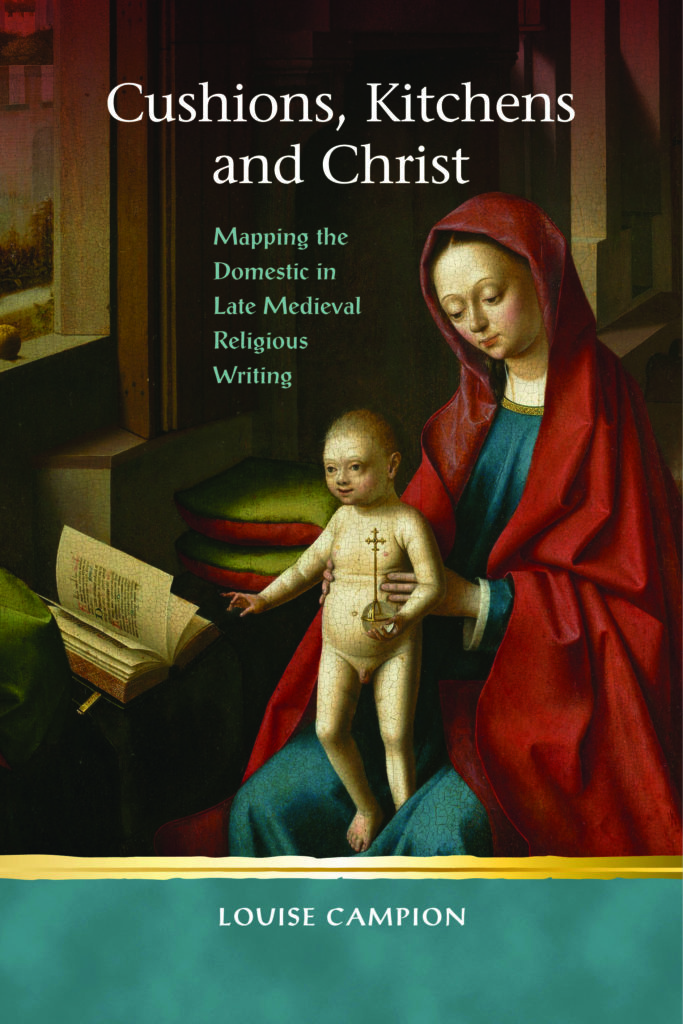
Louise Campion introduces Cushions, Kitchens and Christ: Mapping the Domestic in Late Medieval Religious Writing.
My book is about medieval religious literature. I have to admit, though, that much of the inspiration for the research that shapes the monograph came from an encounter with a much later work of literature. In Iris Murdoch’s 1980 novel Nuns and Soldiers, a nun named Anne is struggling to make sense of a lapse in her faith. One night, Anne gets out of bed to find Jesus standing in her kitchen, with one hand resting on her dining table. Anne is overwhelmed to find Christ in her home, and collapses to the floor.
When I came across this scene in Murdoch’s novel, I was fascinated by its elision of the awesome and the everyday. It then occurred to me that Murdoch was by no means the first writer to situate Christ in a domestic context, making direct contact with the believer. Many hundreds of years earlier, medieval religious writers had been using domestic imagery to explore a whole range of spiritual ideas. Cushions, Kitchens and Christ examines the use of household vocabulary in four fifteenth-century Middle English translations of earlier Latin religious texts. These are the Doctrine of the Hert, a spiritual guidance manual written for an audience of enclosed nuns, the religious visions of Bridget of Sweden and Mechthild of Hackeborn, and the Mirror of the Blessed Life of Jesus Christ, by Nicholas Love, a Life of Christ that was enormously popular in late medieval England.
I am especially interested in the domestic images in the fifteenth-century translations of these texts because, as I argue in the introduction to the book, the literal household sphere was developing significant cultural capital by the 1400s. Late medieval people were spending more money on the adornment of their homes, with cushions becoming particularly popular among middle-class urbanites, and the domestic sphere was developing powerful associations with notions of comfort, privacy and intimacy. This meant that the readers of religious texts were encountering significant patterns of domestic imagery against a backdrop of an increasingly important literal household sphere.
Each chapter of this book examines the patterns of domestic imagery in my four primary texts, before considering how the domestic circumstances of their readers might have shaped the response to these literary households. Some of the imagery I explore is notable for how peculiar it is. The author of the Doctrine of the Hert asks his conventual readers to regard the crucified Christ as meat cooked on a rotisserie, which they must then eat in the sacrament of the Eucharist. In one of Mechthild of Hackeborn’s visions, she imagines that she can hear the whistling of a boiling pot from within one of the wounds in Christ’s feet. Other images are perhaps less strikingly bizarre, but they are no less interesting. In the Mirror of the Blessed Life of Jesus Christ, Love repeatedly situates Christ within households, therefore shifting away from the Gospel narrative of Jesus as a nomadic preacher.
What I aim to show in this book is that the domestic imagery of the late medieval religious text is by no means just a simple and convenient metaphor. It is frequently bold, bizarre and, in the context of fifteenth-century England, hugely pertinent to readers.
Louise Campion is an independent scholar who recently completed an Early Career Research Fellowship in the Institute of Advanced Study at the University of Warwick.


